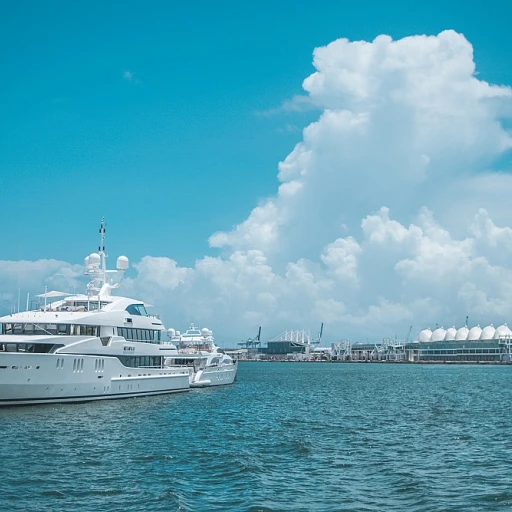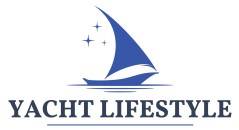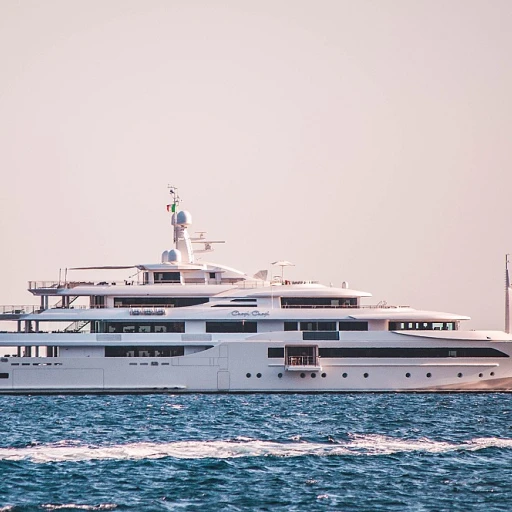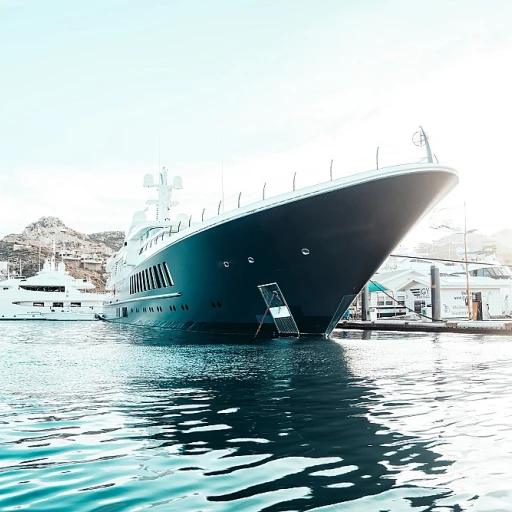
Understanding Yacht Insurance Essentials
Core Components of Yacht Insurance Policies
Every yacht owner should grasp the fundamental elements of yacht insurance. Coverage typically encompasses liability protection, which safeguards against legal responsibilities should your yacht cause injury or property damage. Comprehensive insurance covers virtually all non-collision damage to your yacht, including events like fires and theft. Another pivotal aspect is the agreed value versus actual cash value policies—where the former pays for the yacht's assessed value while the latter considers depreciation. Statistics from industry surveys show that liability claims account for approximately 35% of all marine insurance claims, underscoring the importance of robust liability coverage.
Impactful Variables Influencing Yacht Insurance Premiums
Insurance costs for yachts are not uniform; they can fluctuate based on a number of variables. Key factors include the size and value of the yacht, its age, and the experience level of the captain and crew. Recent market analyses indicate that yachts over 40 feet can expect higher premiums, potentially in the realm of thousands of dollars annually. The geographic location where the yacht will be used and stored also plays a crucial role. In regions prone to hurricanes, like the Florida Coast, insurance premiums can be significantly higher due to the increased risk. Understanding these influencing factors can help yacht owners strategically manage their insurance expenses.
Unraveling the Complexities of the Claim Filing Procedure
Encountering an incident that necessitates filing an insurance claim can be daunting. However, understanding the process can streamline the experience. Typically, it requires the owner to report the incident immediately, document the damage with photos or videos, and prepare a detailed summary of the event. Insurance benchmarks reveal that promptly filed claims have a faster resolution time, often settled within 30 days. Collaborating with marine insurance specialists can facilitate a thorough review and ensure a comprehensive claim is presented.
Proactive Strategies to Ensure Lasting Protection
Evaluating whether your yacht insurance policy is forward-thinking is vital. The marine environment is subject to evolving climate conditions, and as such, insurance policies must be adaptable. Owners should examine if their existing policy includes clauses for emerging risks such as cyber threats or environmental regulations. According to a study conducted by maritime risk experts, less than 20% of yacht policies offered extensive coverage for emerging environmental liabilities. Such foresight can prevent potential future financial pitfalls and ensure enduring peace of mind for yacht owners.
Analyzing the Influencing Factors on Yacht Insurance Costs
Grasping the Basics of Yacht Insurance Coverage
Yacht ownership is synonymous with luxury and leisure, yet it demands a comprehensive understanding of insurance coverage to safeguard such a significant asset. Yacht insurance is designed to provide peace of mind to owners by protecting against a multitude of risks on the water. Akin to auto insurance, coverage includes policies for physical damage, liability, and personal property, catering to both motorized yachts and sailing vessels. According to industry statistics, the peace of mind that comes with yacht insurance is a primary reason 75% of yacht owners opt for comprehensive policies. (Marine Insurance Data, 2022).
Insuring Your Yacht: More Than Just Damage Control
Whereas some may view yacht insurance merely as a protective measure against physical damage, the reality is far more encompassing. Specialty coverages—such as for personal effects, uninsured boater protection, towing and assistance, and even environmental liability coverages—demonstrate the bespoke nature of these policies. Expert tip: 'An ounce of prevention is worth a pound of cure,' thus investing in a robust yacht insurance policy is akin to setting a safety net over the unpredictable seas. The versatility of these policies is highlighted by statistics showing an increase in policy customization, with 60% of yacht insurance holders opting for additional coverages beyond the standard package. (Yacht Coverage Trends Report, 2023).
Crucial Considerations for Comprehensive Protection
Engaging in a deep dive analysis of yacht insurance reveals that several factors influence coverage comprehensiveness: the yacht's size, age, value, usage, and the navigational area all weigh heavily on policy determination. For instance, a yacht used in international waters faces different risk exposures compared to one that sails in local waters, thereby affecting insurance terms and premiums. 'Yacht insurance is not a one-size-fits-all affair,' explains a leading insurance analyst; it requires a keen eye on the vessel's characteristics to ensure that the insurance plan selected provides adequate protection.
- Size and type of yacht
- Age of the yacht
- Value of the yacht
- Navigational area
- Intended use (e.g., private, charter, racing)
This attention to detail can be seen in the market where, according to Yacht Insurers' Annual Review, custom policies have surged by 40% over the last five years as owners seek to tailor their insurance to their unique needs.
Demystifying the Claims Process: A Step-by-Step Guide
The Winter of High Premiums: Seasonal Impacts and Market Trends
In the intricate world of yacht insurance, seasonality plays a pivotal role in determining insurance premiums. For instance, yachts in hurricane-prone areas may face steeper costs during the storm season. Statistics show a notable fluctuation in insurance rates tied to seasonal risks, such as a potential 10-15% hike in premiums during hurricane season for at-risk regions. To navigate these waters adeptly, a yacht owner should chart a course for optimal coverage periods, leveraging market trend data to anchor their insurance expenditures.
Unfolding the Sails: Navigating Size, Value, and Type Variables
The size, value, and type of a yacht unfurl significant influence over insurance costs. Luxury yacht insurance, for high-value vessels, can easily sail north of $10,000 annually, while smaller yachts may dock at a significantly lower premium. The equation is clear—with every additional foot in length, the complexity and value of the vessel—and consequently, the insurance premium—scale up. Seasoned owners know that having precise valuations and specifications on hand is like having a trusted compass in hand—critical for securing fair, balanced insurance rates.
Weathering Experience: The Captain's Credentials
When it comes to steering through the fiscal tempest of yacht insurance premiums, the captain's experience is paramount. Insurers often provide more favorable terms to skilled navigators, quantified through years of seamanship or formal qualifications. In the realm of risk assessment, a captain's proficiency can be as influential as a sturdy hull in calm waters, offering potential premium discounts up to the coveted 5-10% range for demonstrating a steadfast command at the helm.
Navigational Limits and Coverage Scope: Charting Your Course
The waters a yacht traverses can either buoy up or weigh down insurance costs. Exploring international waters can expand the horizon of risk, prompting a rise in insurance investments. On the flip side, limiting a yacht's odyssey to local or less treacherous seas can consolidate coverage and reduce outlay. A smart yacht owner treats their navigational chart like an asset, using it to balance wanderlust with wise insurance choices, effectively optimizing their coverage to align with their seafaring boundaries.
Safety Gear and Protocols: The Lifeline to Lower Premiums
Equipping a yacht with the latest safety gear isn't just a lifesaving strategy—it's a financially astute one. With maritime security technology advancing at a swift knot, integrating cutting-edge safety features can secure more than peace of mind; it can also secure insurance premium discounts. Statistics reveal that yachts equipped with modern safety gadgets and robust emergency protocols can achieve a reduction in insurance costs. A yacht owner's vigilance towards safety is a testament to their commitment to protecting their vessel, and insurers reward this by tightening the lifeline on soaring premiums.
Crewing Up: The Impact of Full-Time vs. Temporary Staff
Finally, the composition of your crew plays a pivotal role in the insurance landscape. A full-time, professional crew may up the ante in terms of upfront insurance costs, yet they simultaneously represent a reduction in operational risk. Insurers often recognize the value of a seasoned crew, evidenced by data showing that a stable and qualified team can lead to favorable insurance terms. Conversely, temporary or less experienced hands on deck might save on wage bills but could inflate insurance premiums, tilting the balance in a less economically favorable direction for yacht owners seeking long-term stability.
Assessing Risk: Is Your Yacht Insurance Future-Proof?
Peeling Back the Layers of the Yacht Insurance Claims Process
Navigating the claims process for yacht insurance can often seem as intricate as sailing through a treacherous reef. However, understanding the critical steps involved can transform this daunting experience into a manageable voyage. According to the latest industry statistics, a clear step-by-step guide helps in expediting claims and significantly reduces discrepancies—increasing the ratio of successful settlements.
- Immediate Notification: At the onset of an incident, prompt notification to your insurer is crucial. It's the hinge on which the claims process swings. Timeliness is not just a courtesy; it's instrumental in facilitating the swift processing of your claim.
- Documentation Galore: The golden rule is 'document everything.' Whether it's a minor scrape or significant damage, compiling comprehensive evidence is key. Insurers indicate that detailed documentation speeds up the review process and aids in verifying the authenticity of the claim.
- Professional Assessment: Insurers often dispatch surveyors to evaluate the extent of damage. They provide a professional's perspective, and their findings are pivotal in claim assessments. Companies using advanced analytics have noticed a 30% increase in accurate damage estimations, which directly influence the claim's outcome.
- Settlement Negotiation: This phase revolves around discussions with your insurer to iron out the specifics of your compensation. Statistics from insurance negotiations reveal that well-prepared owners can expect to secure settlements that are closer to their estimations. In this delicate dance, knowledge is a power that can sway the final number significantly.
Fine-Tuning the Engine: Smoothing Out Claims Discrepancies
Discrepancies in the claims process are not uncommon, and they can serve as significant roadblocks. One report highlighted that resolving such mismatches promptly could reduce the resolution time by as much as 40%. It's vital to approach this with a readiness to provide additional information, a comprehensive understanding of your policy, and a dash of patience.
- Understanding Your Coverage: Comprehending the nuances of your policy can save you from the stormy seas of confusion. A deep dive into your coverage details will illuminate areas that are often the subject of contention during claims.
- Collaborative Communication: Open lines of communication with your insurer support a synergistic resolution approach. Engaging in a professional yet assertive dialogue ensures your voice is heard and your concerns are addressed.
- Professional Advocacy: Sometimes, engaging a claims advocate can spearhead the process towards a favorable conclusion. These experts harness their knowledge to challenge discrepancies and negotiate effectively on your behalf.
Fortifying Against Future Claims: Learnings and Adaptations
The claims process is not only about recovery; it's a learning curve. Insightful yacht owners utilize previous claims as a roadmap for future risk mitigation strategies. Data shows that owners who actively update their risk assessments based on claims history can decrease their chances of repeated incidents by up to 25%. This proactive stance fortifies your yacht against potential pitfalls and, by extension, solidifies your insurance investment.
- Risk Reduction: Implementing changes based on past claims to curtail potential risks is a smart move.
- Policy Update: Regularly updating your policy to reflect the current value and condition of your yacht ensures adequate coverage.
- Continuous Education: Staying informed about new trends in yacht safety and insurance products empowers you to make insightful decisions.






-large-teaser.webp)


